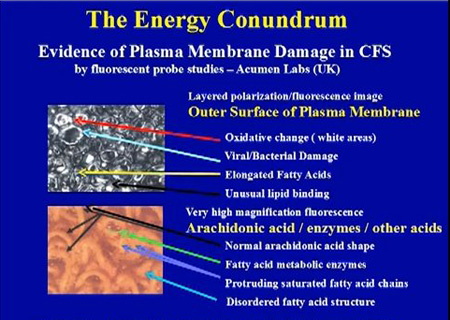| Oxidative and Nitrosative Stress Tests & GSH:GSSG ratio
Scientific and Medical Evidence - Listing of Research conducted worldwide section :
Increased
oxidative stress .
Scientific Findings in Primer for International Consensus Criteria (2012)
Several research studies show high levels of oxidative stress in ME patients. This suggests ongoing damage to the organs, blood vessels and the body. Testing for this will enable a doctor to assess the ongoing damage and recommend antioxidants and medications to counteract this oxidative stress. This is important, in consideration of the fact that many ME patients have suffered premature heart attacks, some have died - Patient deaths from ME . The heart is vulnerable to oxidative stress over a prolonged period of time.

Source: Dr. Paul Cheney, The Cheney Clinic, USA.

Source: Dr. Paul Cheney, The Cheney Clinic, USA
- Concentrations of 8-oxo-dG within cells
- Redox Control
"All CFS cases are toxic to oxygen by echo derived IVRT response criteria as against 1/3 of healthy controls who are mildly toxic to oxygen but when probed carefully are not as healthy as they purport to be."
Dr. Paul Cheney, The Cheney Clinic, USA.
- Test for oxygen toxicity by echo derived IVRT response criteria.
- Test for poor or defective redox control. Poor redox control is found in most ME patients and is related to mitochondrial dysfunctions. It may also be responsble for low sedimentation rates due to oxidative damage to blood cells. These tests are highly recommended by Dr. Paul Cheney.
- Test for
low GSH/GSSG ratios, low NADPH, low SOD or GPx function. Dr. Cheney typically finds
low GSH/GSSG ratios, low NADPH, low SOD or GPx function in his medical practice.
- Measure levels of Nitric Oxide, iNOS, nNOS, eNOS, peroxynitrite, superoxide, and NMDA activity. This is recommended by Dr. Martin Pall.
- Test for malondialdehyde (MDA), isoprostane, 8-OH-deoxyguanosine, 2,3 diphosphoglyceric acid, thiobutyric acid, and protein carbonyls ( Increased
oxidative stress )
- General Inflammation Markers: high-sensitivity c-reactive protein (hs-CRP), white blood cell count (WBC) , IL-6. prostaglandins E2 and C3A . (Psychoneuroendocrinology 2008:33:18-29)
- Increased HDAC
L. A. Jason, M. Sorenson, N. Porter, M. Brown, A. Lerch, J. Mikovits, L. J. Roberts, K. Sebally, D. Alkazemi and S. Kubow, "Increased HDAC is Associated with Hypocortisolism in Older Adults," Manuscript Submitted for Publication, 2011.
- Redlabs in Belgium http://www.redlabs.be
- Total antioxidant capacity in serum
- IgA/IgM against oxidative and nitrosative products
- Fatty acids oxidation (MDA/TBARS)
- Plasma peroxide concentration Test and serum oxLDL antibodies Test are good tests. "Plasma peroxide concentrations were significantly higher in patients with ME/CFS than in normal controls. There was a trend towards significantly higher serum oxLDL antibodies in ME/CFS than in controls. Both biomarkers contributed significantly in discriminating between patients with ME/CFS and normal controls"
Increased plasma peroxides as a marker of oxidative stress in myalgic encephalomyelitis/chronic fatigue syndrome (ME/CFS). Maes M, Kubera M, Uytterhoeven M, Vrydags N, Bosmans E.. Med Sci Monit. 2011 Apr;17(4):SC11-5
- Increased 8-hydroxy-deoxyguanosine
Maes M, Mihaylova I, Kubera M, Uytterhoeven M, Vrydags N, Bosmans E: Increased 8-hydroxy-deoxyguanosine, a marker of oxidative damage to DNA, in major depression and myalgic encephalomyelitis/chronic fatigue syndrome. Neuro Endocrinol Lett 2009, 30:715-722.
- Lipoprotein peroxidation
Manuel-y-Keenoy B, Moorkens G, Vertommen J, De Leeuw I: Antioxidant status and lipoprotein peroxidation in chronic fatigue syndrome. Life Sci 2001, 68:2037-2049.
- Measure levels of Homocysteine
- Increased production of cyclo-oxygenase-2 and inducible NO synthase
Maes M, Mihaylova I, Kubera M, Bosmans E: Not in the mind but in the cell: increased production of cyclo-oxygenase-2 and inducible NO synthase in chronic fatigue syndrome. Neuro Endocrinol Lett 2007, 28:463-469.
- Increased ventricular lactate
Increased ventricular lactate in chronic fatigue syndrome. III. Relationships to cortical glutathione and clinical symptoms implicate oxidative stress in disorder pathophysiology.Shungu DC, Weiduschat N, Murrough JW, Mao X, Pillemer S, Dyke JP, Medow MS, Natelson BH, Stewart JM, Mathew SJ. NMR Biomed. 2012 Sep;25(9):1073-87.
- Nutritional antioxidant deficiencies
- Vitamin E Deficiency
Miwa K, Fujita M: Fluctuation of serum vitamin E (alpha-tocopherol) concentrations during exacerbation and remission phases in patients with chronic fatigue syndrome. Heart Vessels 2010, 25:319-323.
- Coenzyme Q10 Deficiency
Maes M, Mihaylova I, Kubera M, Uytterhoeven M, Vrydags N, Bosmans E: Coenzyme Q10 deficiency in myalgic encephalomyelitis/chronic fatigue syndrome (ME/CFS) is related to fatigue, autonomic and neurocognitive symptoms and is another risk factor explaining the early mortality in ME/CFS due to cardiovascular disorder. Neuro Endocrinol Lett 2009, 30:470-476.
- Glutathione Deficiency
Shungu DC, Weiduschat N, Murrough JW, Mao X, Pillemer S, Dyke JP, Medow MS, Natelson BH, Stewart JM, Mathew SJ: Increased ventricular lactate in chronic fatigue syndrome. III. Relationships to cortical glutathione and clinical symptoms implicate oxidative stress in disorder pathophysiology. NMR Biomed 2012, 25:1073-1087.
- Magnesium Deficiency
Manuel y Keenoy B, Moorkens G, Vertommen J, Noe M, Neve J, De Leeuw I: Magnesium status and parameters of the oxidant-antioxidant balance in patients with chronic fatigue: effects of supplementation with magnesium. J Am Coll Nutr 2000, 19:374-382.
- Do you eat foods containing high levels of toxins ?
- hot dogs
- sodas and fizzy drinks
- foods containing MSG
- foods containing hydrogenated fats
- foods containing saturated fats
- diet drinks containing aspartame
- sausages and cured meats containing nitrosamines
- chlorine in bathing / swimming water
- foods containing additives and flavourings with E numbers
- foods containing toxin residues from the land (arsenic in some rice)
- flouride in drinking water
- un-filtered drinking water
all of these increase toxin load on the body with adverse effects on the body, in particular the immune system, the DNA, the mitochondria, the endocrine system and the brain and nervous system. Eliminate these foods and drinks from the diet.
|

